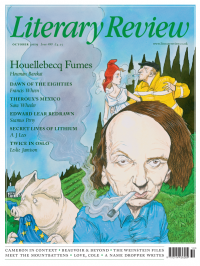David Gilmour
One Nation or Two?
Violencia: A New History of Spain – Past, Present and the Future of the West
By Jason Webster
Constable 418pp £25
After the Fall: Crisis, Recovery and the Making of a New Spain
By Tobias Buck
Weidenfeld & Nicolson 307pp £20
In lines written in 1912, the Sevillian poet Antonio Machado asked God to protect a young Spanish child because otherwise ‘one of the two Spains’ would ‘freeze his heart’. The concept of las dos Españas, two Spains in perpetual conflict has a long history, and it is given vigorous celebration in Jason Webster’s Violencia, in which Machado’s words are quoted. Webster sees the two Spains reflected in the person of Santiago (St James), the son of Zebedee and a disciple of Jesus. Although his connection with Spain is entirely mythical – according to legend, his remains were found in Galicia in the ninth century – he became the country’s patron saint and is seen as the personification of its dual nature: St James the apostle of Christ, and Santiago Matamoros the knight charging on a white horse to slay the ‘Moors’ and reconquer Spain for Christianity. (Webster also grants him a third identity, that of pilgrim and seeker, a man of peace.)
The author sees the two sides of the Spanish soul locked in incessant struggle, one always trying to dominate and annihilate the other: it is ‘a refrain running through the history of the Peninsula’. This has given rise to ‘patterns’ in Spanish history, ‘dualistic conflicts’ between light and dark, between enlightened people and authoritarian conservatives. ‘True to a repeated pattern throughout its history’, Spain is united for a time and then falls apart; all its collapses are caused by civil wars. ‘Ages-long Manichaean struggles’ do not, however, provide the only pattern. We also have the ‘Cassandra pattern, which stretches back over many centuries’, condemning Spain or Spaniards to make prophecies that no one will heed. And we have a still more recondite
pattern, that of a ‘Man from the East’ arriving in Spain and ‘bringing new ways and civilization’. These men include St James, who came from Judaea, the Emir Abd al-Rahman, who came from Damascus, and King Charles III, who came from Naples and ruled Spain in the 18th century. Not many people, I suspect, would compare that Bourbon monarch with Webster’s other ‘Men from the East’.
Webster has lived in Spain for many years and has written a book on flamenco as well as several crime novels featuring a Spanish chief inspector. Violencia is a provocative and entertaining trot through the paradoxes of Spanish history and contains much interesting information: we learn about Sufism in Spain,

Sign Up to our newsletter
Receive free articles, highlights from the archive, news, details of prizes, and much more.@Lit_Review
Follow Literary Review on Twitter
Twitter Feed
It wasn’t until 1825 that Pepys’s diary became available for the first time. How it was eventually decrypted and published is a story of subterfuge and duplicity.
Kate Loveman tells the tale.
Kate Loveman - Publishing Pepys
Kate Loveman: Publishing Pepys
literaryreview.co.uk
Arthur Christopher Benson was a pillar of the Edwardian establishment. He was supremely well connected. As his newly published diaries reveal, he was also riotously indiscreet.
Piers Brendon compares Benson’s journals to others from the 20th century.
Piers Brendon - Land of Dopes & Tories
Piers Brendon: Land of Dopes & Tories - The Benson Diaries: Selections from the Diary of Arthur Christopher Benson by Eamon Duffy & Ronald Hyam (edd)
literaryreview.co.uk
Of the siblings Gwen and Augustus John, it is Augustus who has commanded most attention from collectors and connoisseurs.
Was he really the finer artist, asks Tanya Harrod, or is it time Gwen emerged from her brother’s shadow?
Tanya Harrod - Cut from the Same Canvas
Tanya Harrod: Cut from the Same Canvas - Artists, Siblings, Visionaries: The Lives and Loves of Gwen and Augustus John by Judith Mackrell
literaryreview.co.uk